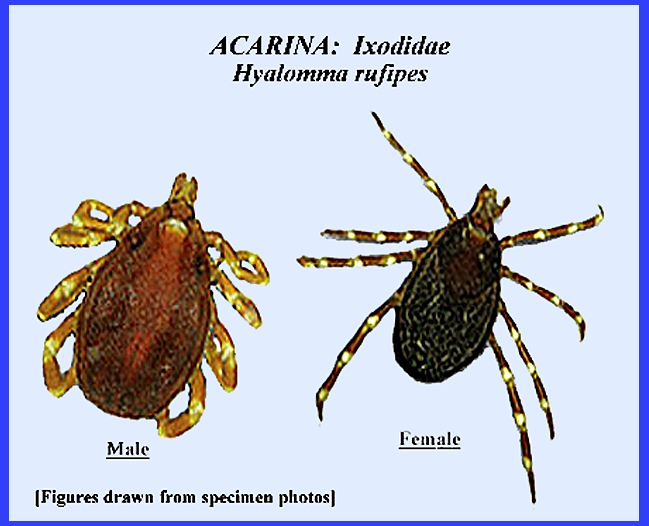File: <crimeancongofever.htm> <Medical Index> <General Index> Site Description
Glossary <Navigate
to Home>
|
CRIMEAN-CONGO HAEMORRHAGIC FEVER (Contact) Please CLICK on
image & underlined links for details: Vectors
include Hyalomma marginatus
marginatum, H. rufipes
and other tick species in the same genus.
Tick larvae and nymphs feed on birds and small mammals, while adults
draw blood from larger mammals including humans. Domestic animals are common amplifying hosts and probably also
serve as reservoirs for the virus.
Birds become involved when they spread infected ticks over vast areas
during migratory flights. Infection can
occur from a tick bite of by crushing an infected tick and even by
contamination from infected blood from a domestic animal. Ticks serve as virus reservoirs because of
their longevity, which can exceed two years.
Venereal transmission occurs when infected tick males mate with
females. This may be followed by
transovarial and transstadial transmissions (Service 2008). = = = = = = = = = = = =
= = = = = = = = Key References: <medvet.ref.htm> <Hexapoda>
Matheson, R. 1950.
Medical Entomology. Comstock
Publ. Co, Inc. 610 p. Service, M. 2008. Medical
Entomology For Students. Cambridge
Univ. Press. 289 p Legner, E.
F.
1995. Biological
control of Diptera of medical and veterinary importance. J. Vector Ecology 20(1): 59_120. Legner,
E. F. 2000. Biological control of aquatic
Diptera. p. 847_870. Contributions to a Manual of Palaearctic
Diptera, Vol. 1, Science Herald, Budapest. 978 p. |
